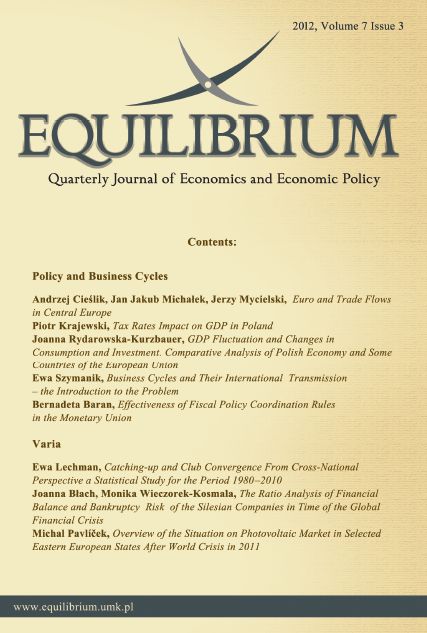Euro and Trade Flows in Central Europe
DOI:
https://doi.org/10.12775/EQUIL.2012.016Keywords
Central Europe, exports, euro, volume of tradeAbstract
In this paper we estimate the trade effects of the euro adoption in Central European countries using a modified gravity model. In particular, we analyze the ex post implications of accession of Slovenia and Slovakia to the Eurozone. We employ a gravity model that controls for an extended set of trade theory and policy variables. Trade theory variables include both the country size and factor proportion variables. Trade policy variables include the membership in GATT/WTO, CEFTA, OECD, EU and Europe Agreements. The gravity model is estimated using the panel data approach on a sample of CEE countries trading with the rest of the world during the period 1992-2009 using the fixed effects, random effects and Hausman-Taylor estimators. It seems that elimination of exchange rate volatility resulted in trade expansion for the CEE countries but the accession to the Eurozone did not have any significant effects on exports of Slovakia and Slovenia.References
Aristovnik A., Meze M., (2009), The Economic and Monetary Union’s Effect on (International) Trade: The Case of Slovenia Before Euro Adoption, “MPRA Paper” No. 17445.
Belke, A. and Spies, J. (2008), Enlarging EMU to the East: What Effects on Trade?, “Empirica”, Vol. 35, pp. 369-389.
Berger H, and Nitsch, V. (2008), Zooming Out: The Trade Effect of the Euro in Historical Perspective, “Journal of International Money and Finance”, Vol. 27, pp. 1244–1260.
Bergstrand, J.H. (1990), The Heckscher-Ohlin-Samuelson Model, The Linder Hypothesis and the Determinants of Bilateral Intra-Industry Trade, “Economic Journal”, Vol. 100, pp. 1216-1229.
Brouwer J., Paap P., and Viaene J-M., (2008), The Trade and FDI Effects of EMU Enlargement, “Journal of International Money and Finance”, Vol. 27, pp. 188-208.
Bun, M. and Klaassen F., (2002), Has the Euro Increased Trade?, “Tinbergen Institute Discussion Paper”, No. 02-108/2.
Cieślik A., (2009), Bilateral Trade Volumes, the Gravity Equation and Factor Proportions, “Journal of International Trade & Economic Development”, Vol. 18, No. 1, pp. 37-59.
Cieślik A., Michałek J.J., Mycielski J. (2009), Prognoza skutków handlowych przystąpienia do Europejskiej Unii Monetarnej dla Polski przy użyciu uogólnionego modelu grawitacyjnego, ”Bank i Kredyt”, Vol. 40, No. 1, pp. 69–88.
Fidrmuc, J. Huber, J. and Michałek, J. (2001), Poland’s Accession to the European Union: Demand for Protection of Selected Sensitive Products, “MOCT-MOST Economic Policy in Transitional Economies”, Vol. 11, pp. 45-67.
Flam, H. and Nordstrom, H. (2003), Trade Volume Effects of the Euro: Aggregate and Sector Estimates, Institute for International Economic Studies, unpublished.
Maliszewska, M.A. (2004), New Member States Trading Potential Following EMU Accession: A Gravity Approach, “Studies and Analyses”, No. 286, CASE – Center for Social and Economic Research.
Micco, A. Stein, E. and Ordonez, G. (2003), The Currency Union Effect on Trade: Early Evidence from EMU, “Economic Policy”, Vol. 18, pp. 315-366.
Rose, A. (2000), One Money, One Market: Estimating the Effect of Common Currencies on Trade, “Economic Policy”, Vol. 15, pp. 7-45.
Rose, A. (2001), Currency Unions and Trade: The Effect is Large, “Economic Policy”, Vol. 16, pp. 449-461.
Rose, A. K. and E. van Wincoop (2001), National Money as a Barrier to Trade: The Real Case for Monetary Union, “American Economic Review”, Vol. 91, pp. 386-90.
Downloads
Published
How to Cite
Issue
Section
Stats
Number of views and downloads: 273
Number of citations: 0



